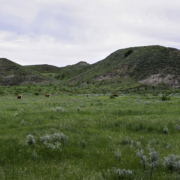Targeted Grazing Can Help Manage Cheatgrass
A study by USDA’s Agricultural Research Service (ARS) and the University of Nebraska–Lincoln (UNL) shows that targeted livestock grazing is a successful and cost-efficient method to manage cheatgrass in the U.S. western Great Plains. Early spring targeted grazing by cattle at just the right time can help limit seed production and reduce the competitiveness of cheatgrass. Scientists say the effective window for targeted grazing lasts approximately 38 days in the spring, from the time the cheatgrass is four inches tall until it’s done flowering. There is some variation in the timing, depending on the year and location. Study results from Nebraska and Wyoming showed that targeted grazing in the early spring can reduce seed production of cheatgrass by as much as 77% when compared to summer grazing. Furthermore, spring targeted grazing can lead to favorable cattle weight gains due to higher crude protein and energy in cattle diets during this period.


 USDA MEDIA BY LANCE CHEUNG.
USDA MEDIA BY LANCE CHEUNG.